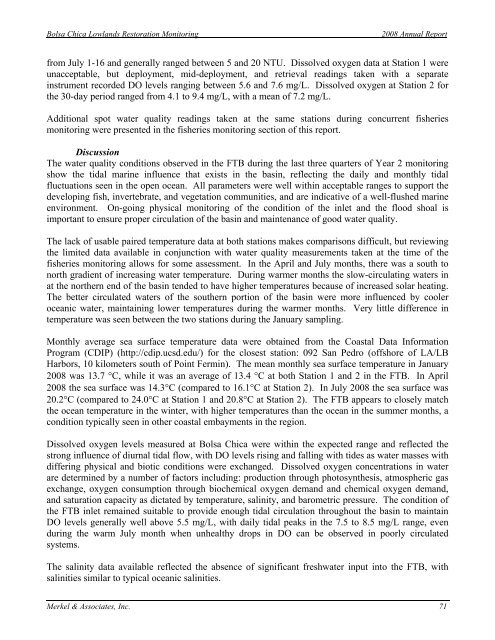2008 Annual Monitoring Report (pdf 10.9MB) - Bolsa Chica ...
2008 Annual Monitoring Report (pdf 10.9MB) - Bolsa Chica ...
2008 Annual Monitoring Report (pdf 10.9MB) - Bolsa Chica ...
Create successful ePaper yourself
Turn your PDF publications into a flip-book with our unique Google optimized e-Paper software.
<strong>Bolsa</strong> <strong>Chica</strong> Lowlands Restoration <strong>Monitoring</strong><br />
<strong>2008</strong> <strong>Annual</strong> <strong>Report</strong><br />
from July 1-16 and generally ranged between 5 and 20 NTU. Dissolved oxygen data at Station 1 were<br />
unacceptable, but deployment, mid-deployment, and retrieval readings taken with a separate<br />
instrument recorded DO levels ranging between 5.6 and 7.6 mg/L. Dissolved oxygen at Station 2 for<br />
the 30-day period ranged from 4.1 to 9.4 mg/L, with a mean of 7.2 mg/L.<br />
Additional spot water quality readings taken at the same stations during concurrent fisheries<br />
monitoring were presented in the fisheries monitoring section of this report.<br />
Discussion<br />
The water quality conditions observed in the FTB during the last three quarters of Year 2 monitoring<br />
show the tidal marine influence that exists in the basin, reflecting the daily and monthly tidal<br />
fluctuations seen in the open ocean. All parameters were well within acceptable ranges to support the<br />
developing fish, invertebrate, and vegetation communities, and are indicative of a well-flushed marine<br />
environment. On-going physical monitoring of the condition of the inlet and the flood shoal is<br />
important to ensure proper circulation of the basin and maintenance of good water quality.<br />
The lack of usable paired temperature data at both stations makes comparisons difficult, but reviewing<br />
the limited data available in conjunction with water quality measurements taken at the time of the<br />
fisheries monitoring allows for some assessment. In the April and July months, there was a south to<br />
north gradient of increasing water temperature. During warmer months the slow-circulating waters in<br />
at the northern end of the basin tended to have higher temperatures because of increased solar heating.<br />
The better circulated waters of the southern portion of the basin were more influenced by cooler<br />
oceanic water, maintaining lower temperatures during the warmer months. Very little difference in<br />
temperature was seen between the two stations during the January sampling.<br />
Monthly average sea surface temperature data were obtained from the Coastal Data Information<br />
Program (CDIP) (http://cdip.ucsd.edu/) for the closest station: 092 San Pedro (offshore of LA/LB<br />
Harbors, 10 kilometers south of Point Fermin). The mean monthly sea surface temperature in January<br />
<strong>2008</strong> was 13.7 °C, while it was an average of 13.4 °C at both Station 1 and 2 in the FTB. In April<br />
<strong>2008</strong> the sea surface was 14.3°C (compared to 16.1°C at Station 2). In July <strong>2008</strong> the sea surface was<br />
20.2°C (compared to 24.0°C at Station 1 and 20.8°C at Station 2). The FTB appears to closely match<br />
the ocean temperature in the winter, with higher temperatures than the ocean in the summer months, a<br />
condition typically seen in other coastal embayments in the region.<br />
Dissolved oxygen levels measured at <strong>Bolsa</strong> <strong>Chica</strong> were within the expected range and reflected the<br />
strong influence of diurnal tidal flow, with DO levels rising and falling with tides as water masses with<br />
differing physical and biotic conditions were exchanged. Dissolved oxygen concentrations in water<br />
are determined by a number of factors including: production through photosynthesis, atmospheric gas<br />
exchange, oxygen consumption through biochemical oxygen demand and chemical oxygen demand,<br />
and saturation capacity as dictated by temperature, salinity, and barometric pressure. The condition of<br />
the FTB inlet remained suitable to provide enough tidal circulation throughout the basin to maintain<br />
DO levels generally well above 5.5 mg/L, with daily tidal peaks in the 7.5 to 8.5 mg/L range, even<br />
during the warm July month when unhealthy drops in DO can be observed in poorly circulated<br />
systems.<br />
The salinity data available reflected the absence of significant freshwater input into the FTB, with<br />
salinities similar to typical oceanic salinities.<br />
Merkel & Associates, Inc. 71






